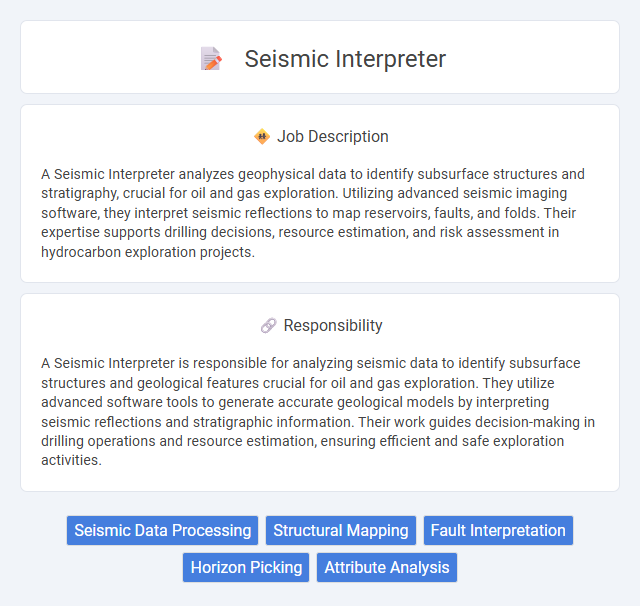
A Seismic Interpreter analyzes geophysical data to identify subsurface structures and stratigraphy, crucial for oil and gas exploration. Utilizing advanced seismic imaging software, they interpret seismic reflections to map reservoirs, faults, and folds. Their expertise supports drilling decisions, resource estimation, and risk assessment in hydrocarbon exploration projects.
Individuals with strong analytical skills and a keen attention to detail are likely to excel as seismic interpreters, as the role requires interpreting complex subsurface data. Those comfortable working with advanced software and able to handle high-pressure environments may find this job suitable. Candidates with a background in geophysics or geology and a passion for seismic data analysis probably have the highest chances of success in this field.
Qualification
A Seismic Interpreter typically requires a bachelor's degree in geophysics, geology, or petroleum engineering, complemented by proficiency in seismic data analysis software such as Petrel or Kingdom. Strong analytical skills and experience with seismic attributes, velocity modeling, and well log correlation are essential for accurate subsurface interpretation. Certifications in seismic interpretation and ongoing training in latest seismic processing technologies enhance job qualifications and career advancement.
Responsibility
A Seismic Interpreter is responsible for analyzing seismic data to identify subsurface structures and geological features crucial for oil and gas exploration. They utilize advanced software tools to generate accurate geological models by interpreting seismic reflections and stratigraphic information. Their work guides decision-making in drilling operations and resource estimation, ensuring efficient and safe exploration activities.
Benefit
Seismic interpreters likely experience significant benefits such as enhanced career opportunities in the oil and gas industry, driven by their specialized skills in analyzing seismic data. The role may offer competitive salaries and the chance to work with advanced geophysical technology, increasing job satisfaction. Opportunities for professional growth and contributing to resource discovery projects could further enhance the appeal of this career path.
Challenge
Seismic interpreter roles likely demand high analytical skills to accurately analyze complex geological data sets and identify subsurface structures. The challenge may involve working with ambiguous or incomplete seismic data, requiring interpretation under uncertainty while balancing speed and precision. Interpreters probably face pressure to provide reliable insights that directly impact exploration and drilling decisions, making attention to detail crucial.
Career Advancement
Seismic Interpreters analyze subsurface geological data to identify oil and gas reservoirs, utilizing advanced software and seismic imaging technology. Career advancement often involves progressing to Senior Seismic Interpreter roles, where responsibilities expand to project management and strategy development within exploration teams. Expertise in geophysical data integration and strong analytical skills further open pathways to leadership positions such as Geoscience Manager or Exploration Director.
Key Terms
Seismic Data Processing
Seismic interpreters specializing in seismic data processing analyze subsurface geological formations using advanced signal processing techniques and algorithms to enhance data quality and resolution. They apply filtering, migration, and amplitude correction methods to raw seismic datasets, enabling accurate identification of hydrocarbon reservoirs and fault structures. Expertise in software tools such as Petrel, Kingdom, and MATLAB is crucial for transforming seismic traces into interpretable geological models.
Structural Mapping
Seismic interpreters specializing in structural mapping analyze subsurface seismic data to delineate geological structures such as faults, folds, and stratigraphic layers. They utilize advanced software and seismic attributes to create accurate 3D models that support hydrocarbon exploration and reservoir characterization. Proficiency in seismic signal processing and geological principles is essential for identifying structural traps and guiding drilling decisions.
Fault Interpretation
Seismic interpreters specializing in fault interpretation analyze subsurface seismic data to identify and map geological faults critical for hydrocarbon exploration and reservoir characterization. Advanced seismic attributes and 3D visualization techniques enable accurate delineation of fault planes, displacement, and connectivity, enhancing risk assessment and drilling decisions. Expertise in structural geology and seismic processing software ensures precise interpretation of fault geometry and its impact on fluid migration and trap integrity.
Horizon Picking
Seismic interpreters specializing in horizon picking analyze subsurface seismic data to identify and map geological layers with precision. Accurate horizon picking enhances reservoir characterization and supports exploration by delineating stratigraphic boundaries and fault structures. Expertise in seismic attribute analysis and software tools like Petrel or Kingdom is essential for efficient horizon identification and geological modeling.
Attribute Analysis
Seismic interpreters specializing in attribute analysis extract valuable quantitative data from seismic volumes to identify subsurface features such as faults, fractures, and lithology variations. Utilizing advanced software tools, they analyze amplitude, frequency, and phase attributes to enhance reservoir characterization and improve exploration accuracy. Their expertise in interpreting attribute data supports decision-making processes in hydrocarbon exploration and geotechnical assessments.
 kuljobs.com
kuljobs.com